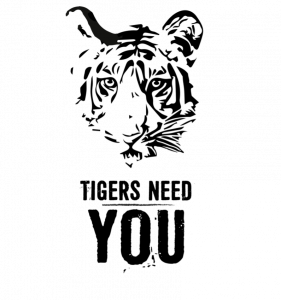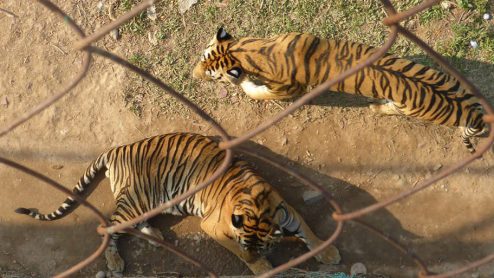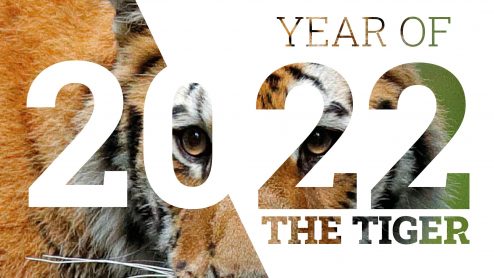On International Tiger Day the world’s tigers need you to help create a stripe-pattern database!
Whether you call it Global Tiger Day or International Tiger Day, 29 July has been designated an annual opportunity to celebrate the tiger and all it represents and to raise awareness of what we have to do to reverse decades of decline.
There are an estimated 4,500* endangered wild tigers remaining across Asia, with seizures and trade observations indicating that poaching to feed demand is still a major threat to their survival.
This year, in partnership with the Alan Turing Institute, the UK’s institute for data science and artificial intelligence (AI), we invite you to help us develop an AI tool to contribute to law enforcement efforts. A tiger’s stripes are as unique as our fingerprints and the ultimate long-term ambition is to create a new globally accessible method and database for law enforcement agencies and researchers to identify individual tigers from the stripe patterns – from images of skins they see for sale physically and digitally, from seized tiger skins and from captive tigers. This will help trigger and facilitate cooperation.
EIA has a database of hundreds of images of tiger skins (skin rugs, taxidermy specimens, carcasses) we have documented for sale online and in persistent trade hubs and have collated from open source images of seized tigers. We know other organisations and researchers similarly collect such images and when we swap images it currently involves a manual scan to determine if there is a match.

The first step is to learn from existing tools and develop, train and test new AI technology. To do that, we need thousands of images including, but not limited to, images of known individual tigers and multiple images of the same tiger from different angles. This is where you come in. We know you have your favourite tigers that you photograph in the wild, some of which you have followed for years. Or maybe you have photographs of known individuals of tigers in zoos or rescue centres.
You can help by submitting your pictures with relevant information via this website form.
The Alan Turing Institute is named after the pioneering computer scientist and philosopher who helped crack Germany’s Enigma Code during World War Two, which saved thousands of lives; his likeness appears on the £50 banknote.
A Turing-sponsored doctoral researcher will spend six months using the images to develop the technology and the project will also be taken up by a longer-term Turing Data Study Group. The initial goal will be for us to be able to cross-reference new tiger skin images that we capture against our existing database of tiger skin images and we can help other researchers, NGOs and law enforcement do the same. Beyond that, we would like to see a global database being created, held by a neutral body that we can all access, add to and cross-reference images of skins against using the developed technology.
If you have any questions or would like to know more about the EIA Tiger Stripes Project, please email [email protected]
EIA in the Year of the Tiger
As we entered the Lunar New Year in 2022, the Year of the Tiger in the Chinese Zodiac, we set out our hopes and expectations for leadership and renewed commitment to the Global Tiger Recovery Programme. In a presentation to the 4th Asia Ministerial Conference on Tiger Conservation, we highlighted the threat to wild tigers (and other big cats) from unchecked demand, the supply of tiger parts from farms perpetuating and stimulating that demand, the persistent physical and digital markets for tiger parts and we issued a Call to Action to political leaders.
Throughout the year, we have collaborated with NGO colleagues and contributed to a vision for the tiger’s future beyond 2022 and to a proposal outlining the scope of special missions by the Secretariat of the Convention on International Trade in Endangered Species (CITES), to countries with captive tiger facilities of concern. We are working especially closely with our friends at Education for Nature Vietnam and Wildlife Friends Foundation Thailand, building on previous collective efforts to document tiger trade and tiger farming across South-East Asia, with support from the UK Government through the Illegal Wildlife Trade Challenge Fund. By providing information to law enforcement, the private sector and policy-makers, we can help them disrupt the trade networks and strengthen laws to end tiger farming.
*4,500 wild tigers
Earlier this month, the International Union for the Conservation of Nature (IUCN) released the latest estimate of the global wild tiger population. They are still endangered and still a fraction of the 100,000 tigers believed to have roamed across Asia 120 years ago.
The scientists wisely cautioned against drawing comparisons against more recent estimates since 2010 and the last Year of the Tiger, and instead recommend this be seen as the new baseline. The reason for their caution is that previous estimates were based on less robust methodology across the tiger’s range, even now they note that different tiger range countries are using different methodologies, so things are still not perfect in terms of estimations, just better.
The recent IUCN assessment drew from national data as at 2020 and it notes there will be revised estimates from India, Nepal and perhaps elsewhere that will change the numbers again in 2022. There may well be a flurry of news stories about percentage increases in the number of tigers, rather than an increase in the number of tigers counted. There have undoubtedly been tiger population increases here and there, tigers returning to forests they have not been seen in for a long time, but we must not forget that in the past 12 years, tigers have gone extinct in Laos, Cambodia and Vietnam and are catastrophically close to extinction in Malaysia and Myanmar.





